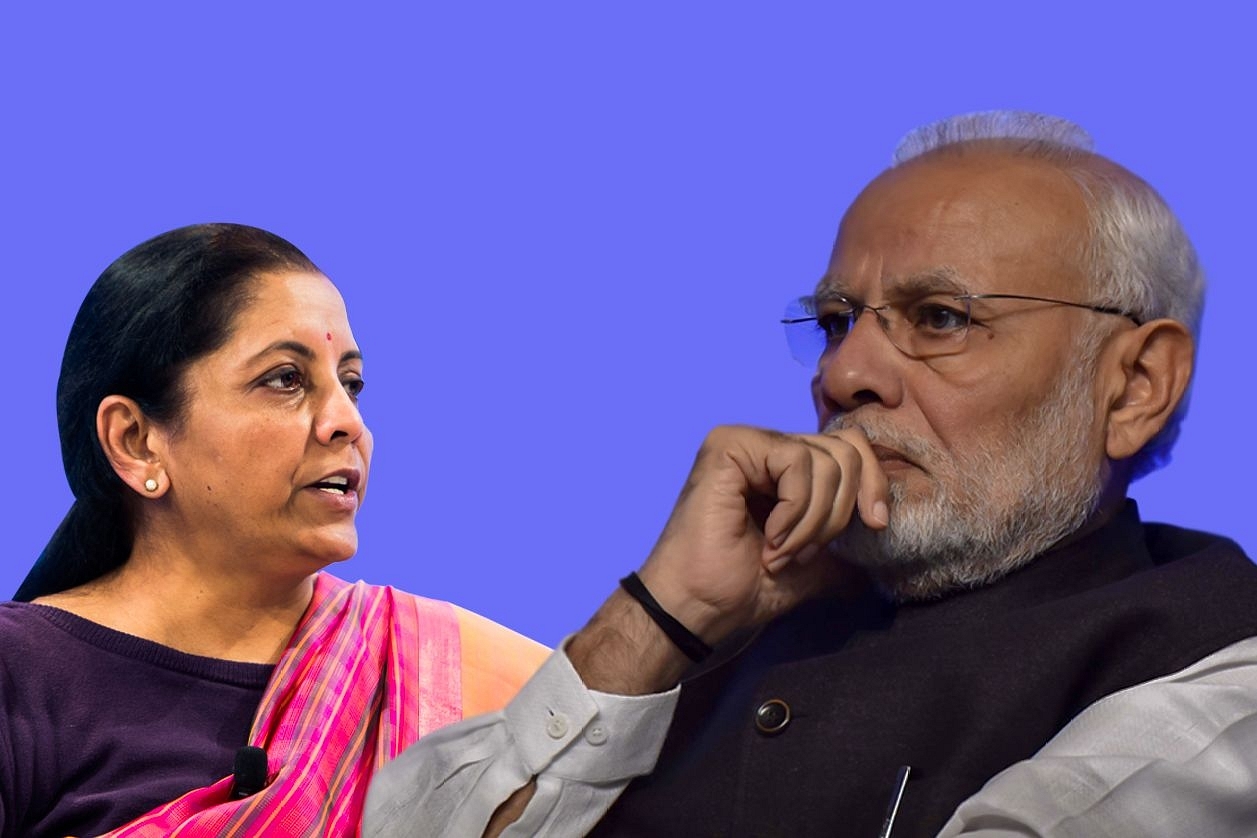Economy
Is It 2008 Once More? Even If It Isn’t, Modi And Sitharaman Should Treat It As One
- For the Indian economy, which is still to show a clear recovery, 2020 looks worse than 2008 because 12 years ago our economy was booming; this time it is clearly in crisis.

Finance Minister Nirmala Sitharaman and Prime Minister Narendra Modi.
If Monday, 9 March, brought back memories of the 2008 Lehman crisis, it is not without reason. Everything that could crash, crashed.
The Dow collapsed over 2,000 points, forcing the US stock exchanges to stop trading for a while.
The BSE Sensex nosedived by 1,941 points after looking much worse intra-day. It has essentially wiped out all the gains that accrued over the last one year.
Brent crude, the benchmark for Indian imports, skidded so hard that, at one point, it fell below $30 to a barrel.
The only thing that boomed were bonds. Both the 10-year US Treasury and the 10-year Government of India (GOI) bonds gained prices — which is the same as saying that yields crashed. The US Treasury yield went as low as 0.35 per cent before recovering. It is now around 0.69 per cent. Ten-year GOI yields temporarily dipped below 6 per cent before closing at 6.07 per cent.
The big question that no one knows the answer to is whether it is 2008 all over again. With trade wars yet to cease, with Covid-19 far from contained, with global supply chains disrupted, with commodity prices crashing and consumers turning tail, it does indeed seem so.
For the Indian economy, which is still to show a clear recovery, 2020 looks worse than 2008 because 12 years ago our economy was booming; this time it is clearly in crisis. In 2008, the Reserve Bank of India (RBI) could cut rates fast, and the government could chop excise rates to boost demand and prevent a credit freeze.
This time credit growth is already sluggish, and many sectors are in deep crisis — telecom, real estate, power, infrastructure, autos, non-bank finance companies, et al. To top it all we have a deep political crisis and a nation at war with itself over the Citizenship Amendment Act 2019 — a humane law that has been repeatedly misinterpreted by the opposition and Muslims as something against their interests.
So what can the government do now? One can talk about factor market reforms, agricultural reforms, etc, but in the short term, the remedies are the same as the one adopted by Manmohan Singh: Keynesian pump-priming.
If anything, this time those fiscal and monetary easing measures are even more warranted, as the Indian economy itself is in trouble. Even if 2020 is not 2008, India should treat it like 2008.
There are no two ways about it.
First, the fiscal deficit target of 3.8 per cent is no longer worth adhering to. The government has to use fiscal resources to push the economy forward. This means more capital for banks, more money for infrastructure, and revenue-forgoing packages for telecom and power, among other sectors.
Second, privatisation must be pushed even harder even if the price realisation are lower than expected. This is the only unconventional source of revenue still open to the government to boost spending without letting the fisc slide out of control.
BPCL and Air India must be sold, and so must Concor, some land banks, and assets like highways and pipelines. The need of the hour is to raise more resources for the exchequer.
Many political critics will look at this as selling the household silver to finance current consumption, but when your house is on fire, that’s not the time to worry about whether you are emptying the water tank to put the fire out. The correct sequence is put the fire out, and then worry about how to replenish the water used.
Third, the RBI must cut interest rates significantly, for this has two benefits: one, it forces banks to pass on the cuts to revive consumption and investment; and two, a drop in rates improves their profits since existing bonds go up in value.
The Monetary Policy Committee (MPC) can be ignored, or scrapped. The RBI should be empowered to act on its own if the worthies on the MPC think inflation is the bigger threat. Actually, an accelerating slowdown should be the big worry.
If an economy’s choice is between slightly higher inflation and deflation, one must choose the former any day. The economic consequences of deflation — or even a deepening growth recession — are devastating for a low middle income country like India.
PS: Prime Minister Narendra Modi must remember Deng Xiaoping’s quote: it does not matter what colour the cat is as long as it catches mice. In Modi’s case, the cat is black money. He must use every opportunity to bring it all back through generous amnesty schemes so that it helps revive the economy. A black cat is as good as a white cat in this situation.
Support Swarajya's 50 Ground Reports Project & Sponsor A Story
Every general election Swarajya does a 50 ground reports project.
Aimed only at serious readers and those who appreciate the nuances of political undercurrents, the project provides a sense of India's electoral landscape. As you know, these reports are produced after considerable investment of travel, time and effort on the ground.
This time too we've kicked off the project in style and have covered over 30 constituencies already. If you're someone who appreciates such work and have enjoyed our coverage please consider sponsoring a ground report for just Rs 2999 to Rs 19,999 - it goes a long way in helping us produce more quality reportage.
You can also back this project by becoming a subscriber for as little as Rs 999 - so do click on this links and choose a plan that suits you and back us.
Click below to contribute.
Latest